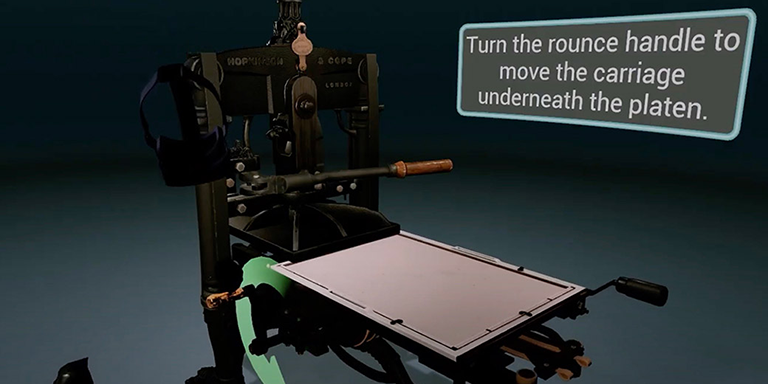RESOURCES
BLOG
Join in the community forum! The thINK blog is a place for community members to share their opinions, best practices, successes, and challenges. Add your comments to the blogs published here or write a blog and we’ll post it for you.

A Virtual Reality Printing Press
In an intriguing pairing of the old and the new, students at Rochester Institute of Technology (RIT) have created a virtual reality (VR) application of the letterpress printing process. In tandem with RIT faculty, the students modeled their work on the Kelmscott/Goudy Albion press that is housed at the Cary Graphic Arts Collection at RIT. The goal was to create a digital twin of the press. The application is called the “19th-Century Printing Press Experience VR” and is free on the Steam digital distribution platform.
Starting with the Old
The name “Kelmscott/Goudy Albion” reflects the heritage and ownership of this 19th Century cast iron hand press. The word “Albion” is the maker’s brand. This type of printing press was designed by Richard Whittaker Cope and was produced in London. Manufactured for more than a century, RIT’s Kelmscott/Goudy Albion press was built in 1891 by Hopkinson & Cope. It is believed that Cope chose the name “Albion” because of its use as a poetic name for England. This helped at the time to distinguish it from an American competitor, the Columbian press (invented by George Clymer in Philadelphia in 1813).
The word “Kelmscott” is a reference to its first owner, the British designer William Morris. Morris founded the Kelmscott Press and was a leader within the British Arts and Crafts movement. Morris used the press to produce his book entitled “The Works of Geoffrey Chaucer” (1896).
And what about “Goudy”? The press was acquired by the American type designer Frederic Goudy in 1924. He bought the press and had it shipped to New York for his own use with his Village Press.
The press passed through multiple owners, including Melbert B. Cary Jr., the Director of Continental Type Founders Association and Proprietor of the private Press of the Woolly Whale, who owned it from 1932 to 1941. (Note: RIT’s special collections library is named after Cary.) The Cary Graphic Arts Collection bought the press at auction in December 2013 for $233,000. The press is one of the highlights of their collection.
On to the New
Imagine this: You put on VR goggles and reach your gloved hands toward a virtual printing press. You are greeted with the words, “Welcome! Are you ready to print using an iron hand press? To begin, please pick up the brayer to your right.” Soon you will know that a brayer is used to ink the platen before putting paper into position and applying pressure to transfer the ink.
As you begin, sounds and tactile pressure in the controller extend the experience of inking the platen or pulling the handle to apply pressure. Credits or prompts will help steer you in the right direction. All the while, spectators can view your progress via a screen that displays your movements. Soon you are printing. Well, virtually at least.
Conclusion
Although this VR app was a student exercise, it’s important not to underestimate the potential uses of this technology in the printing industry. Apps like this one will become mainstream for use in training, technical support, and repair. The choice of a relatively straightforward mechanical device like an Albion press simplifies the creation of a VR app, but it is clear that the path forward will lead to more complex devices. We will certainly see apps like this expanded to devices with integrated hardware and software components before long. For now, though, the 19th-Century Printing Press Experience VR app will give remote students and researchers a closer look at how a press like the Kelmscott/Goudy Albion operates.
Author bio: Jim Hamilton of Green Harbor Publications (www.greenharbor.com) is an industry analyst, market researcher, writer, and public speaker. For many years he was Group Director in charge of Keypoint Intelligence’s (formerly InfoTrends’) Production Digital Printing & Publishing consulting services. He has a BA in German from Amherst College and a Master’s in Printing Technology from the Rochester Institute of Technology.
